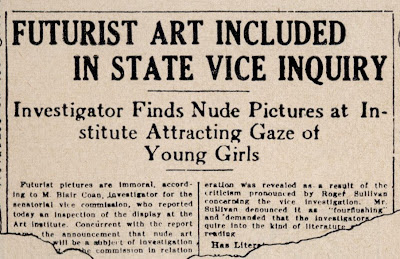THE GAZE OF YOUNG GIRLS

In 1913, a pernicious little busybody named M. Blair Coan spied on visitors to an art exhibit in Chicago. Coan, an investigator for the State Vice Commission, was upset by the "immorality" of modern paintings and suspected that Matisse's painting of nude dancers might even be "attracting the gaze of young girls."

Coan stirred up a great public outcry against immoral art. He then turned his talents to spreading alarm about the imminent communist takeover of the United States. In one of his books, The Coming Peril, Coan warned that socialism would ruin society by encouraging free love and giving women the right to vote. For Coan, the most "monstrously immoral" threat was that socialism might permit white women to consort with men of other races:
The negro and the white woman, the white woman and the Chinaman, They draw no race line or color line in the [Socialist] party.Each new generation must battle its own versions of Coan. Personally, I wouldn't know "immoral art" if I saw it. Rodin used to say, "There should be no argument in regard to morality in art; there is no morality in nature." But even if we all agreed on one standard for morality in art, the law is just not well suited to prevent people from drawing dirty pictures. Author Stephen Becker wrote about the futility of using law as a tool to shape human nature:
Man comes first with his lusts, and then the law, usually in the form of an infinitely reticulated mechanism that serves variously as strait jacket, leg iron or chastity belt. Or that should so serve; but in its preventive function it usually fails and thus becomes merely punitive, the rationale for thumbscrew or dungeon or guillotine.Today, organizations such as the Comic Book Legal Defense Fund do excellent work helping to keep that punitive function from getting out of hand.
That's the easy part.
Now let's turn back to the gaze of young girls.
I may have trouble recognizing when art is immoral, but I have no trouble recognizing when art is coarse, shallow or laughably immature. A number of popular artists such as Serpieri, who is an able draftsman, have a penchant for drawing beautiful women being gang raped by monsters.

Dozens of other best selling artists, such as Manara or Noe, make a fine living selling highly explicit pictures of adolescent male fantasies. And these are the best of the bunch. There are hundreds of artists out there who, judging from their work, seem to be training to illustrate gynecology textbooks.
I am not morally or legally opposed to this kind of art. I sometimes have aesthetic objections, but not enough to merit burning the books or jailing the artist.
At the same time, we let ourselves off too easily if we deny that there are gentle young things in the world (girls or boys) that deserve a chance to find their footing unmolested. And you don't have to be Coan to conclude that easily accessible extreme images from books, magazines and the internet can distort that process.
That's what I would like to chat about in the next few postings: the artistic quality and social impact of this kind of art, the virtues of extremism and the virtues of moderation. I trust that, as usual, you will have some strong opinions to express and some good artists to recommend.


